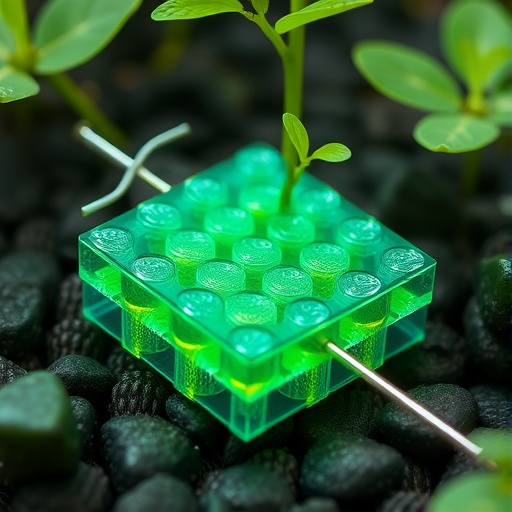In an era where industrial and agricultural chlorinated organic pollutants (COPs) chronically contaminate soils and groundwater, a revolutionary approach to accelerate their breakdown has emerged. Persistent pollutants like tetrachloroethene and trichloroethene pose serious environmental and health risks due to their recalcitrance and longevity in ecosystems. Traditional means of remediating these toxins rely heavily on microbial electrorespiration and reductive dechlorination facilitated by electrode-respiring bacteria, but slow progress and reliance on costly trial-and-error experimentation have limited their deployment. Now, a cutting-edge machine learning–guided inverse design framework promises to transform bioelectrodechlorination into a rapid, efficient, and eco-friendly process, redefining the future of bioremediation technology.
This pioneering framework integrates sophisticated machine learning algorithms, including random forest, multilayer perceptron, and extreme gradient boosting (XGBoost), with high-resolution microbial community data to optimize critical parameters like cathode potential, temperature, and microbial composition. By leveraging an extensive dataset of 357 data points sourced from 68 peer-reviewed studies, researchers crafted predictive models that capture the intricate interplay of electrochemical conditions, microbial biofilm profiles, and experimental designs. The models demonstrate impressive accuracy, achieving pollutant degradation predictions with less than a 6% margin of error — a level of precision previously unattainable through conventional methods.
The significance of these findings transcends theoretical modeling. Incorporating genus-level microbial data vastly improved predictive accuracy, underscoring the vital role of bacterial taxa such as Clostridium, Desulfovibrio, Geobacter, and Dehalococcoides in the dechlorination process. These bacteria function as bioelectrochemical catalysts, facilitating electron transfer and reductive reactions that break down stubborn chlorinated compounds. Notably, the framework’s use of particle swarm optimization configured optimal conditions—specifically, cathode potentials ranging from −260 to −510 millivolts and a temperature near 23 degrees Celsius—that maximize dechlorination rates for key pollutants.
Environmental engineering has long grappled with the heterogeneity of aquifer systems and the unpredictable dynamics of microbial communities, which hamper efficient pollutant degradation. This ML-driven approach effectively navigates these complexities by dynamically adjusting system variables based on predictive outputs, significantly reducing reliance on laborious and resource-intensive lab experiments. This methodological leap not only accelerates pollutant degradation but also enhances scalability and sustainability, aligning with global environmental management goals.
From an ecological perspective, the implications are profound. Persistent organic pollutants accumulate and disseminate through water tables and soils, imperiling biodiversity and public health. By delivering a data-driven blueprint for bioremediation, this framework facilitates the restoration of contaminated sites with unprecedented speed and resource efficiency. Life cycle analyses further reveal that the optimized bioelectrodechlorination process diminishes global warming potential by nearly 15 kilograms of CO₂-equivalent emissions and substantially lowers energy consumption, situating it as a green alternative in pollution mitigation strategies.
Additionally, the integration of microbial community insights into inverse design frameworks represents a paradigm shift, marrying microbiology with systems engineering and artificial intelligence. As microbial ecology unveils functional interdependencies within biofilms, predictive models can now exploit these biological signatures to fine-tune electrochemical conditions, thereby enhancing biodegradation reactions. Such synergy accelerates discovery, allowing researchers to transcend static experimentation and adopt reactive, adaptive methodologies geared toward environmental challenges.
Corresponding author Prof. Aijie Wang emphasized the transformative potential of this approach, stating that coupling microbial ecology with machine learning obviates the need for lengthy trial-and-error optimization. Instead, it allows practitioners to pinpoint effective bioelectrodechlorination operational settings with remarkable precision, conserving time and financial resources. Besides delivering pragmatic benefits, this framework also enriches scientific comprehension of microbial community contributions to pollutant breakdown, bridging disciplinary gaps from laboratory research to real-world environmental applications.
Looking ahead, this ML-based inverse design system is poised to catalyze broader adoption of bioelectrochemical techniques beyond COP remediation. Potential avenues include wastewater treatment, bioenergy generation, and the elimination of emerging contaminants, domains where bioelectrochemical dynamics and microbial consortia play pivotal roles. The model’s modularity affords incorporation of expanding datasets—including genomic and functional gene profiles—which can elevate prediction fidelity and adaptability to diverse environmental matrices.
The convergence of machine learning, bioelectrochemistry, and microbial ecology embodied in this new framework signals a future where sustainable remediation processes are no longer limited by empirical bottlenecks. Rather, they are governed by intelligent systems capable of self-optimizing and scaling, offering promising prospects for cleaner aquifers, revived ecosystems, and healthier communities. This innovation sets a precedent for interdisciplinary efforts harnessing artificial intelligence to tackle some of the most pressing environmental contamination challenges of our time.
In sum, this study represents a watershed moment in environmental science and engineering, revealing how technology can expedite pollutant degradation efficiently and reliably. The data-driven strategies detailed herein will likely inspire a wave of research and development focused on refining bioelectrochemical remediation systems with unprecedented control and foresight. As these methods mature and integrate with broader environmental monitoring frameworks, they hold the promise to reshape the landscape of pollution abatement and resource recovery worldwide.
Subject of Research: Not applicable
Article Title: Accelerating Bioelectrodechlorination via Data-Driven Inverse Design
News Publication Date: 27-Sep-2025
References:
DOI: 10.1016/j.ese.2025.100625
Image Credits: Environmental Science and Ecotechnology
Keywords: Machine learning
Tags: advanced electrochemical remediation methodsbioelectrodes for eco-friendly remediationchlorinated organic pollutants degradationdata-driven environmental solutionseco-friendly wastewater treatment technologieselectrode-respiring bacteria advancementsenvironmental health risk reductionhigh-resolution microbial community analysisinnovative bioremediation techniquesmachine learning in bioremediationmicrobial electrorespiration optimizationpredictive modeling for pollutant breakdown





